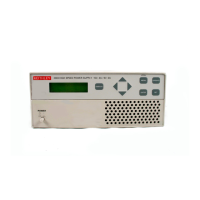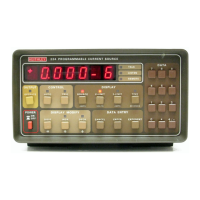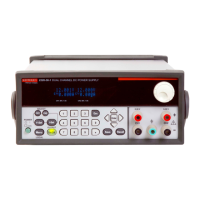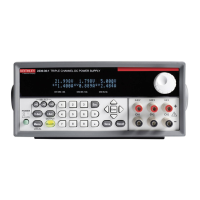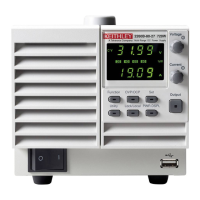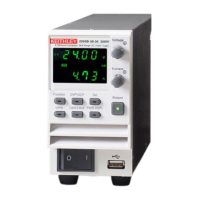External Triggering (Model 2306-VS Only) 6-13
1. For optimal speed, have trigger external enabled on both channels even if you intend to
use only a single channel.
2. The trigger in and trigger out pulse may be configured to occur on the RISING or
F
ALLING edge of the pulse based on the setting of the TRIG:EXT:EDGE commands
for IN and OUT.
3. Each step has a voltage value associated with it as well as a delay setting. The voltage
and delay v
alues is set by TRIG:EXT:STEP command. Up to 20 steps may be
configured.
4. To have the voltage step value used, the TRIG:EXT:STEP:VOLT setting must be set to
ON.
If voltage stepping only, the steps will cycle back to 1 and continue stepping after
performing step number of POINts.
5. To have an additional user delay besides the internal delay (trigger latency), the delay for
a step must
have a non-zero value.
6. If readings are taken during the step, a complete cycle through the number of steps
(TRIG
:EXT:STEP:POIN setting) must be completed before using a FETCh:ARRay?
query for the data. Monitor the buffer full bit in the status model (Section 8) for a channel
or monitor trigger out pulses to determine when a FETCh:ARRay? query can be sent.
The qu
ery must correspond to the channel taking the measurement regardless of the
BOTH setting. When taking measurements, the cycling stops after POINts step
measurement is completed, so the FETCh:ARRay? query may be sent before starting a
new set of measurements. To take another set of measurements, send the
TRIG:EXT:ENAB:INIT command.
7. Use the TRIG:EXT:STEP? query to view the next step to be performed.
8. Once the handshake occurs on the trigger out pulse, the instrument is ready for the next
tri
gger in pulse unless a complete set of POINts measurements has been taken. In this
case, the TRIG:EXT:ENAB:INIT command must be sent to resume taking measure-
ments. Make sure after generating a trig
ger in pulse that the trigger out pulse is detected.
After detecting the trigger out, generate another trigger in pulse. Once detecting a trigger
in pulse, another one is not detected until the trigger out pulse pulses.
9. For the channel configurations with BOTH set to VOLT or AUTO, only a single delay is
incurred
for the given channel configuration. If the BOTH setting is VOLT for channel
2, that step delay for channel 2 is incurred before going to the next aspect of the
configuration.
10. If BOTH is set to VOLT or AUTO for a channel, that channel is the one the trigger in
pulse needs to
occur on and the trigger out pulse will occur on.
11. When recalling a setup (user or *RST), the unit will turn the display ON and set both
chan
nels TRIG:EXT:ENAB command setting to OFF regardless of how saved. Like the
Model 2306, the output state is recalled being OFF.
12. If TRIG:EXT:ENAB is ON for a channel and a
n exception occurs regardless of channel
or exception (current limit tripping either channel, VPT either channel, heat sink too hot
or power supply too hot), the display state is turned ON, the output is turned OFF,
voltage is set to TRIG:EXT:VOLT:STEP:END value and TRIG:EXT:ENAB is set to
OFF for that channel. Part of exception handling these conditions is exiting trigger
external functionality. See “Outputting voltage and current” in Section 2 for current limit
and VPT information.
13. While using the trigger external features on
a channel, that channel will always monitor
for current limit tripping on either channel, for VPT on either channel, and for the heat
Test Equipment Depot - 800.517.8431 - 99 Washington Street Melrose, MA 02176
TestEquipmentDepot.com
